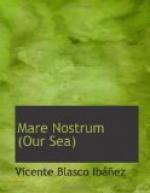This animal and vegetable dust nourishes the most numerous species which, in their turn, serve as pasture for the great swimmers armed with teeth.
The whales, most bulky of all the oceanic inhabitants, close this destructive cycle, since they devour each other in order to live. The Pacific giant, without teeth, supplies his organism with plancton alone, absorbing it by the ton; that imperceptible and crystalline manna nourishes his body (looking like an overturned belfry), and makes purple, fatty rivers of warm blood circulate under its oily skin.
The transparency of the beings in the plancton recalled to Ferragut’s memory the marvelous colorings of the inhabitants of the sea, adjusted exactly to their needs of preservation. The species that live on the surface have, as a general rule, a blue back and silver belly. In this way it is possible for them to escape the sight of their enemies; seen from the shadows of the depths, they are confounded with the white and luminous color of the surface. The sardines that swim in shoals are able to pass unnoticed, thanks to their backs blue as the water, thus escaping the fish and the birds which are hunting them.
Living in the abysses where the light never penetrates, the pelagic animals are not obliged to be transparent or blue like the neritic beings on the surface. Some are opaque and colorless, others, bronzed and black; most of them are clad in somber hues, whose splendor is the despair of the artist’s brush, incapable of imitating them. A magnificent red seems to be the base of this color scheme, fading gradually to pale pink, violet, amber, even losing itself in the milky iris of the pearls and in the opalescence of the mother-of-pearl of the mollusks. The eyes of certain fish placed at the end of jaw bones separated from the body, sparkle like diamonds in the ends of a double pin. The protruding glands, the warts, the curving backs, take on the colorings of jewelry.
But the precious stones of earth are dead minerals that need rays of light in order to emit the slightest flash. The animated gems of the ocean—fishes and corals—sparkle with their own colors that are a reflex of their vitality. Their green, their rose color, their intense yellow, their metallic iridescence, all their liquid tints are eternally glazed by a moist varnish which cannot exist in the atmospheric world.
Some of these beings are capable of a marvelous power of mimicry that makes them identify themselves with inanimate objects, or in a few moments run through every gamut of color. Some of great nervous activity, make themselves absolutely immovable and contract, filling themselves with wrinkles, taking on the dark tone of the rocks. Others in moments of irritation or amorous fever, cover themselves with streaks of light and tremulous spots, different colored clouds passing over their epidermis with every thrill. The cuttlefish and ink fish, upon perceiving that they are pursued, enwrap themselves in a cloud of invisibility, just as did the enchanters of old in the books of chivalry, darkening the water with the ink stored in their glands.




